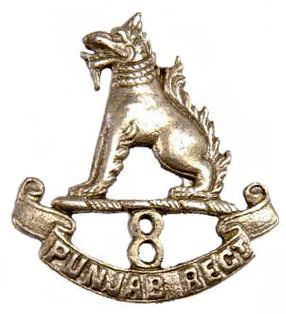Active 1922 - 1956 | Type Line Infantry Uniform Drab; faced blue | |
 | ||
Branch | ||
The 8th Punjab Regiment was a regiment of the British Indian Army from 1922 to 1947. It was transferred to Pakistan Army on Partition of India in 1947 and merged with the Baluch Regiment in 1956.
Contents
Madras Infantry
The 8th Punjab Regiment had its origins in the Madras Army, where its first battalion was raised at Masulipatam in 1798. Four more battalions were raised in 1799-1800. In 1824, they were designated as the 29th, 30th, 31st, 32nd and 33rd Regiments of Madras Native Infantry. In the early 19th century, these battalions were engaged in fighting the Marathas and took part in a number of foreign expeditions including the Anglo-Burmese Wars. Between 1890 and 1893, they were reconstituted with Punjabi Muslims and Sikhs as Burma Battalions and permanently based in Burma to police the turbulent Burmese hill tracts. Under the Kitchener Reforms of 1903, they were redesignated as the 89th, 90th, 91st, 92nd Punjabis, and 93rd Burma Infantry. They were delocalized from Burma before the First World War.
First World War
Only 2/89th Punjabis of the wartime raisings was retained after the post-war reforms.
The 8th Punjabis have a most distinguished record of service during the First World War. Their long list of honours and awards includes the Victoria Cross awarded to Naik Shahmed Khan of 89th Punjabis in 1916. The 89th Punjabis had the unique distinction of serving in more theatres of war than any other unit of the British Empire. These included Aden, where they carried out the first opposed sea-borne assault landing in modern warfare, Egypt, Gallipoli, France, Mesopotamia, North-West Frontier Province, Salonika and Russian Transcaucasia. All battalions served in Mesopotamia, while 93rd Burma Infantry also served in France. The 92nd Punjabis were made 'Prince of Wales's Own' in 1921 for their gallantry and sacrifices during the war.
In 1922, the five battalions along with the war-raised 2/89th Punjabis were united to form the 8th Punjab Regiment:
The new class composition of the 8th Punjab Regiment was Punjabi Muslims, Sikhs and Hindu Gujars. Chinthe - the mythical Burmese lion-dragon guardian of Buddhist pagodas was chosen as its new emblem. The uniform was of drab colour with blue facings. In inter-war period, the Regiment saw extensive service on the North West Frontier of India.
Second World War
During the Second World War the 8th Punjab Regiment again distinguished itself, suffering more than 4500 casualties. It was awarded two Victoria Crosses to Havildar Parkash Singh and Sepoy Kamal Ram, besides numerous other gallantry awards. The regiment raised a further nine battalions. Two of its battalions, the 1st and 7th, were captured on Singapore Island, when the British Commonwealth Army surrendered there to the Japanese on 15 February 1942. Four battalions fought in the Burma Campaign, while others saw service in Iraq, Iran, Italy, French Indochina and the Dutch East Indies. Two men from the 8th Punjab Regiment received the Victoria Cross: Havildar Parkash Singh in Burma and Sepoy Kamal Ram in Italy. By the end of the war, the Regiment consisted of 14 Battalions. However, most of the war-raised units were disbanded in 1946 except the 6th and 8th Battalions.
Post-independence history
In 1947, the 8th Punjab Regiment was allocated to Pakistan, and Sikhs and Gujars were exchanged with Hindustani Muslims from units allotted to India. In January 1948, 6th Battalion was disbanded, only to be re-raised in October along with the 9th Battalion, in response of the Kashmir War with India. In 1956, the eight battalions of 8th Punjab Regiment were merged with the Baluch Regiment. Their new designations were:
Battle honours
Cochin, Maheidpoor, Ava, Afghanistan 1878-80, Burma 1885–87, China 1900, Loos, France and Flanders 1915, Macedonia 1918, Helles, Krithia, Gallipoli 1915, Suez Canal, Egypt 1915, Megiddo, Sharon, Palestine 1918, Tigris 1916, Kut al Amara 1917, Baghdad, Khan Baghdadi, Mesopotamia 1915–18, Afghanistan 1919, The Trigno, Perano, The Sangro, Gustav Line, Monte Grande, The Senio, Italy 1943-45, North Malaya, Jitra, Gurun, Kampar, Malaya 1941–42, Donbaik, North Arakan, The Shweli, Myitson, Kama, Burma 1942–45.
